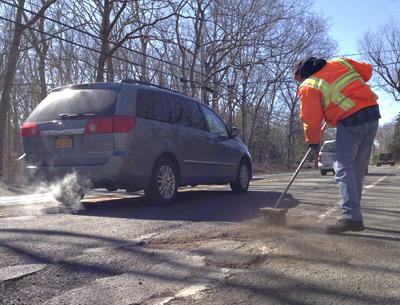Drowning in Potholes

People often take the back roads to avoid traffic, but this time of year they might be doing the same to get around the myriad massive potholes that pockmark Route 27 from Water Mill to Montauk.
Two factors have combined to make this year’s crop especially treacherous for drivers. First and most obvious, this winter has been a particularly brutal one, with frequent snow, ice, and frigid temperatures giving way to brief thaws, before the cycle repeats again. The fluctuation in temperatures, paired with all that ice and snow, are “wreaking havoc on the roads of Long Island,” Eileen Peters, a spokeswoman for the New York State Department of Transportation, said Tuesday. The second factor, exacerbated by the first, is that the asphalt on long sections of the state-owned roadway is at the end of its normal lifespan.
The worst parts of Route 27 were last resurfaced 12 to 14 years ago. The expected lifespan for the asphalt used is about 10 years, depending on weather and traffic volume, Ms. Peters said. Heavy traffic takes a greater toll on the roads, and heavy truck traffic an even greater toll, she said, explaining that “one 16-wheel tractor-trailer is the equivalent of 10,000 passenger vehicles” in terms of the damage it can do.
A short stretch of the highway, from Stephen Hand’s Path to the intersection of Buell Lane in East Hampton, was milled and resurfaced last spring and is holding up well under winter’s abuse, but the miles between the intersection of County Road 39 and Montauk Highway in Southampton and Stephen Hand’s Path, and from Buell Lane all the way to South Etna Avenue in Montauk, are due to be resurfaced sometime this year.
The contractor who won the bid for resurfacing both those sections of highway is handling pothole repairs on those stretches in the meantime, while the Department of Transportation does repairs elsewhere on Route 27 and on other state roads like Route 114. A start date for the resurfacing should be announced by late March or early April, Ms. Peters said. “They need humidity and temperatures to cooperate for the full resurfacing.” She expects that work will be done during “off-peak hours or at night,” but could offer no specifics about when it might commence or how long it is expected to take.
“Our priority right now is to keep the roads safe,” Ms. Peters said. Between plowing, treating the roads for snow and ice, and attending to potholes, “we are using every possible resource this winter,” she said. The same trucks and crews handle those jobs, keeping them very busy this year.
Last year the D.O.T. spent $354,877 repairing potholes on Long Island, Ms. Peters said in an email. Since October, the department has spent almost $1.4 million on those same roads. The weekend of Feb. 22 and 23, when temperatures reached as high as the 50s, crews used 136 tons of asphalt to repair potholes on the Long Island Expressway alone, she said.
If all those repairs seem to have left out the ones most vexing to you, fret not. Motorists can call the state’s toll-free number — 800-POTHOLE — to report potholes on state roads so that crews can be alerted and sent out to fill them as weather permits.
